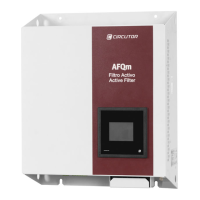72
AFQm
Instruction Manual
This mode minimises the amount of power used by the device to compensate for reactive power, thus
reducing its energy consumption.
Range of values: 0.7... -0.7
Press the key to access the next configuration step
Press the key to access the main screen of the device without saving the configuration values.
7.8.- IEEE519
Note: This screen is not visible on the “slave” devices.
This screen, Figure 77, may be configured if the device is to comply with the filtering limits specified in
the IEEE 519-2014 standard:
Figure 77: Configuration screen: IEEE519.
● IEEE519
The device includes harmonic filtering functions to adjust the power for each harmonic to ensure that
the installation complies with the limits under the IEEE 519-2014 standard. This standard gives rec-
ommendations regarding the harmonic emission limits generated by an installation, in order to avoid
both internal and external damage to devices and triggering of protections.
The standard specifies the limits for each harmonic at the network operator’s connection point, its
magnitude depending on the line’s short-circuit impedance, and maximum load current demand.
The aim is to limit current harmonics so that voltage distortion caused by them is acceptable. Accord-
ingly, a network with a high short-circuit impedance is more prone to voltage distortions caused by
the harmonic current, so the IEEE 519-2014 standard is more stringent than in an installation with a
lower short-circuit impedance.
For the user, only three parameters need to be entered when configuring the device, which will auto-
matically select the maximum harmonic values to comply with the standard:
Note: If this function is enabled, the device will only correct the harmonics to meet the requirements
of the established limits, instead of trying to cancel the harmonics altogether.

